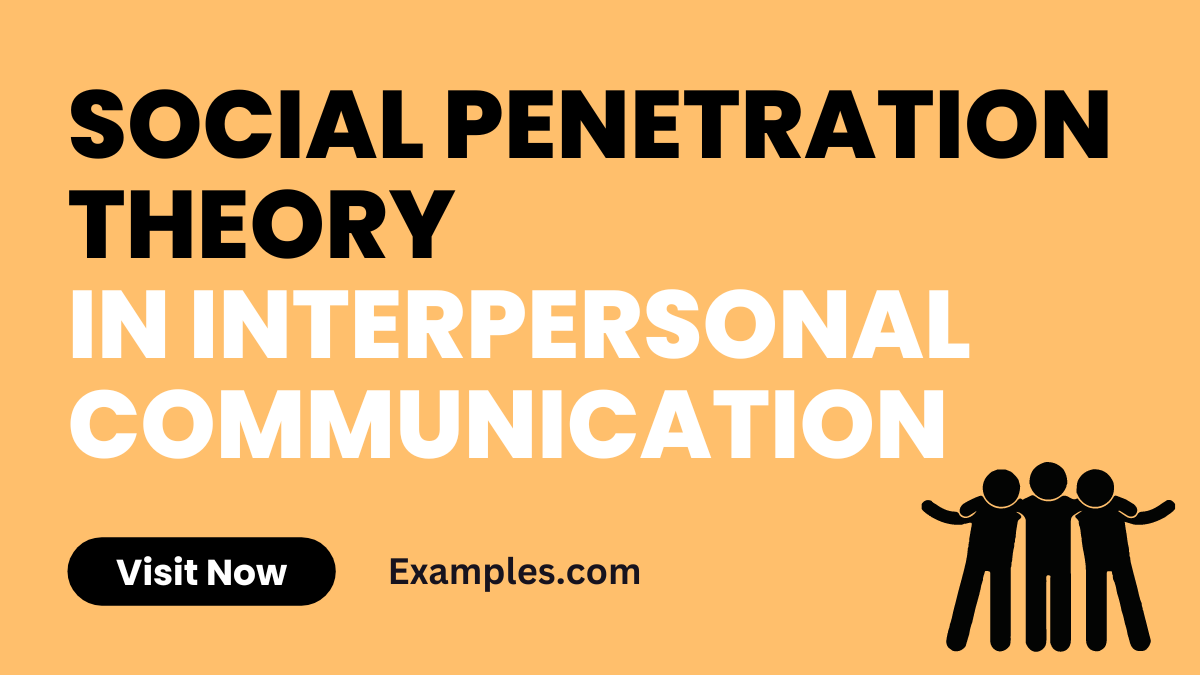19+ Social Penetration Theory in Interpersonal Communication Examples
Social Penetration Theory plays a crucial role in Interpersonal Communication. This theory explains how relationships progress from superficial to more intimate levels. By understanding this theory, individuals can effectively navigate the intricacies of building and maintaining meaningful connections. The theory illustrates that as people communicate, they gradually reveal layers of themselves, akin to peeling an onion. Each layer represents deeper and more personal aspects of one’s self. This guide will delve into how this theory applies to various types of interpersonal interactions, offering practical examples to demonstrate its significance in everyday life.
What is Social Penetration Theory in Interpersonal Communication?
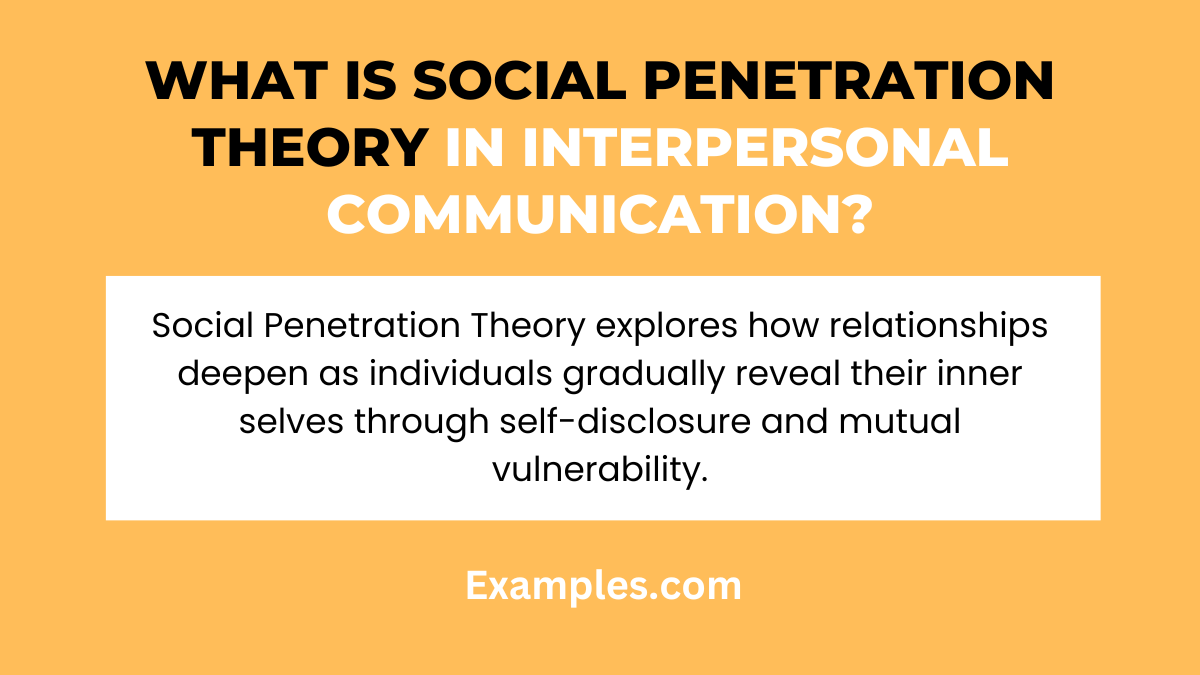
Social Penetration Theory in Interpersonal Communication refers to a psychological concept that describes how relationships develop over time. It’s based on the notion that as people interact, they gradually disclose personal information, moving from superficial to more intimate levels of communication. This progression is similar to peeling the layers of an onion, revealing more about one’s thoughts, feelings, and experiences. The theory emphasizes the importance of self-disclosure and trust in fostering deeper connections with others.
History
Who Created: Dalmas Taylor
Date: 1973
Social Penetration Theory in Interpersonal Communication stands as a significant framework in understanding how interpersonal relationships develop over time. This theory, central to the Theories of Interpersonal Communication, was first introduced by psychologists Irwin Altman and Dalmas Taylor in 1973, marking a pivotal moment in the study of interpersonal dynamics.
The inception of Social Penetration Theory was influenced by the growing need to understand the intricacies of human relationships. Altman and Taylor were intrigued by how relationships progressed from superficial levels to more intimate ones. They proposed that this evolution occurs through a process of self-disclosure, where individuals gradually reveal personal information, thoughts, and feelings.
What is the Best Example of Social Penetration Theory in Interpersonal Communication?
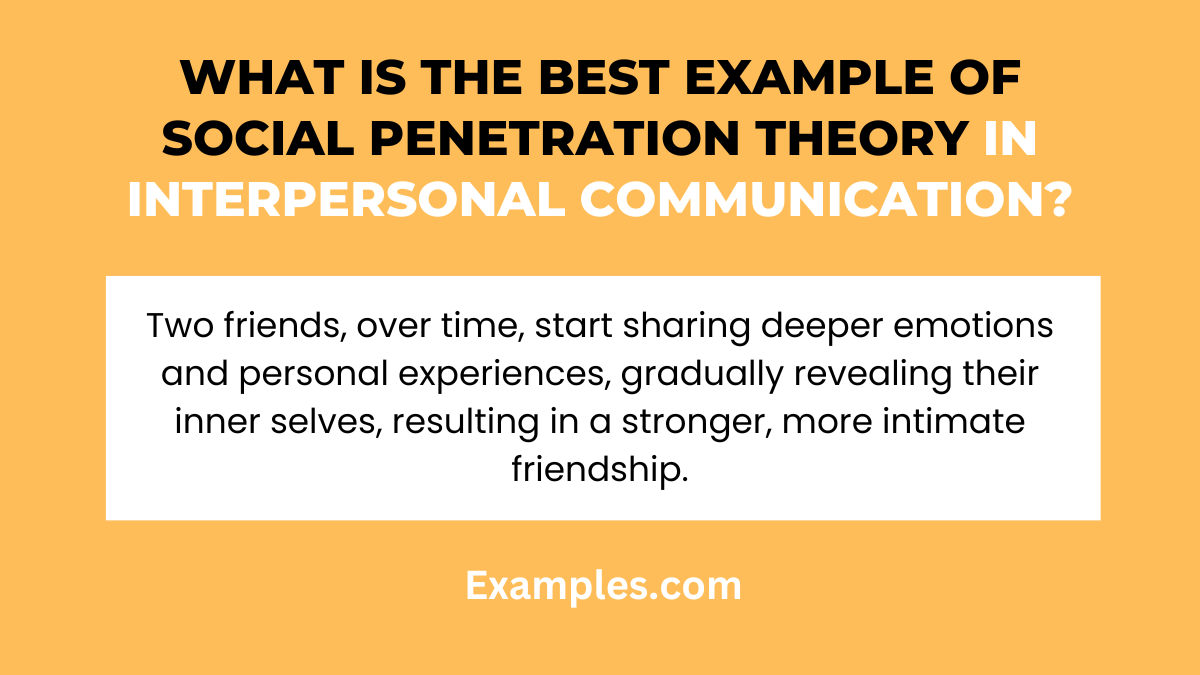
A classic example of Social Penetration Theory in Interpersonal Communication is the development of a friendship. Initially, conversations might revolve around general topics like weather or current events. As comfort and trust build, discussions may advance to sharing personal experiences, beliefs, and emotions. For instance, two colleagues might start by talking about work-related subjects. Over time, as they feel more comfortable with each other, they might begin sharing personal stories, family backgrounds, or even challenges they face in life. This gradual increase in the depth of conversation exemplifies how social penetration theory operates in day-to-day interactions, deepening interpersonal connections.
20 Examples of Social Penetration Theory in Interpersonal Communication
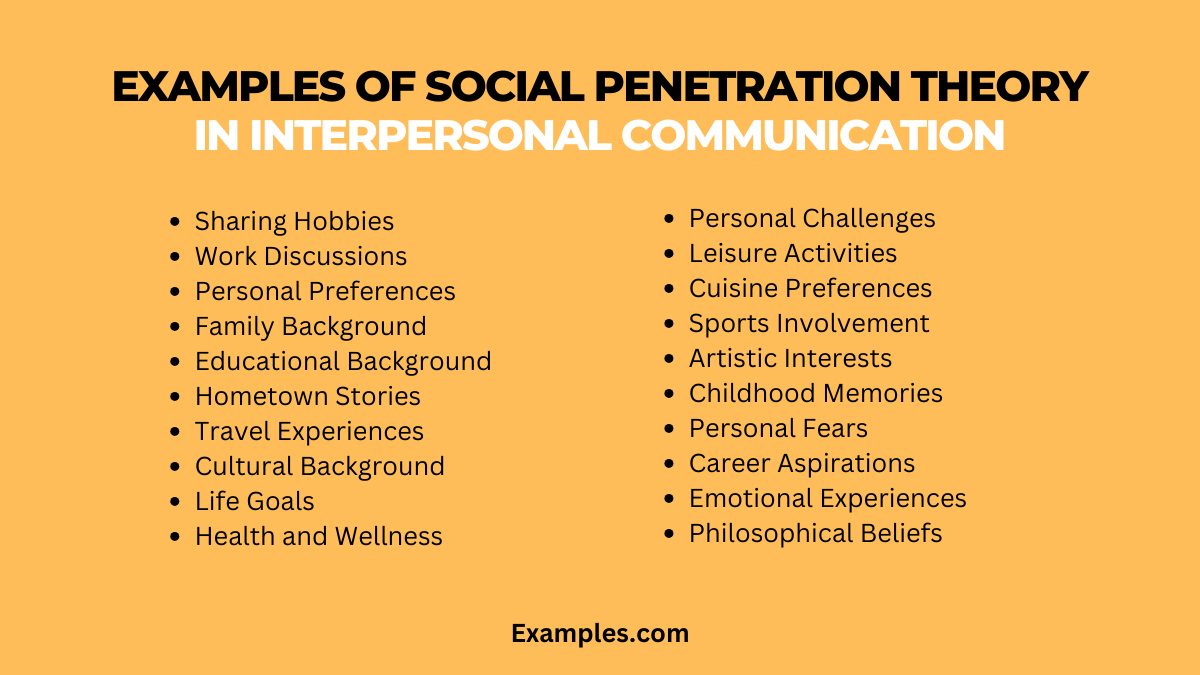
Understanding the dynamics of interpersonal communication is crucial in our daily interactions. The Social Penetration Theory, a cornerstone in communication studies, offers valuable insights into how relationships progress from superficial layers to deeper, more intimate levels.
- Sharing Hobbies: Initially, you mention enjoying music. As comfort grows, you share your passion for playing the guitar.
Example: “I love listening to rock music. Recently, I’ve been learning to play the guitar myself.” - Work Discussions: A conversation starts with discussing job titles. Later, it delves into personal experiences and challenges at work.
Example: “I’m a project manager. Lately, the job’s been challenging with tight deadlines and team dynamics.” - Personal Preferences: Initially, you mention preferring coffee over tea. Later, you share stories about your coffee-tasting adventures in Italy.
Example: “I always start my day with coffee. I remember tasting some exquisite blends in Italy last summer.” - Family Background: Conversations evolve from stating the number of siblings to sharing childhood memories and family traditions.
Example: “I have two sisters. We used to go camping every summer as a family tradition.” - Educational Background: You start by mentioning your degree and eventually share your college experiences and the impact on your career choices.
Example: “I studied Psychology, which was challenging yet fascinating. It led me to my current career in counseling.” - Hometown Stories: Beginning with stating your hometown, conversations progress to sharing nostalgic stories about growing up there.
Example: “I’m from Boston. I have fond memories of attending baseball games with my dad at Fenway Park.” - Travel Experiences: Initial talks about favorite destinations lead to sharing personal anecdotes from various travels.
Example: “I love traveling to Europe. On my last trip to Paris, I experienced some really interesting cultural differences.” - Cultural Background: Conversations shift from mentioning your cultural heritage to sharing cultural practices and personal values.
Example: “I’m of Italian descent. Family gatherings and hearty meals are a big part of our family culture.” - Life Goals: Discussions evolve from stating career goals to sharing personal life ambitions and dreams.
Example: “I aim to be a successful writer. Eventually, I want to write a book that inspires people to overcome challenges.” - Health and Wellness: You begin by discussing generic wellness habits and gradually share personal health journeys or struggles.
Example: “I try to stay active. Last year, I overcame a major health setback, which changed my perspective on fitness.” - Personal Challenges: Starting with general challenges at work or life, the conversation shifts to sharing personal struggles and learning experiences.
Example: “Balancing work and life is tough. I’ve been learning to manage stress better after experiencing burnout.” - Leisure Activities: From mentioning general interests like reading, discussions delve into favorite authors and the impact of certain books.
Example: “I enjoy reading. ‘To Kill a Mockingbird’ deeply influenced my views on justice and morality.” - Cuisine Preferences: Initial food preferences lead to sharing memorable dining experiences or personal cooking stories.
Example: “I love Thai food. I once took a cooking class in Bangkok and learned to make authentic Pad Thai.” - Sports Involvement: Conversations shift from favorite sports to personal experiences in playing or watching significant games.
Example: “I’m a big basketball fan. Watching my first live NBA game was an unforgettable experience.” - Artistic Interests: Starting with a general interest in art, you later share your journey in learning or appreciating a particular art form.
Example: “I appreciate modern art. Recently, I’ve started exploring abstract painting techniques myself.” - Childhood Memories: From a brief mention of childhood, you share specific, impactful experiences from your early years.
Example: “Growing up, I spent a lot of time outdoors. Building treehouses was my favorite childhood activity.” - Personal Fears: Discussions evolve from general fears to sharing deeper anxieties or phobias and their origins.
Example: “I’m not a fan of heights. A scary fall when I was young has made me extra cautious on ladders.” - Career Aspirations: You begin with stating your current job and eventually share your ultimate career aspirations and the steps you’re taking to achieve them.
Example: “I’m currently in marketing, but my dream is to start my own business focusing on sustainable products.” - Emotional Experiences: Initial talks about general feelings evolve into sharing significant emotional experiences and their impact.
Example: “I generally stay optimistic. However, losing my grandfather last year was a period of deep reflection and sadness for me.” - Philosophical Beliefs: Conversations start with basic beliefs and values, advancing to deeper discussions about life philosophies and ideologies.
Example: “I believe in living a balanced life. Studying Eastern philosophies has deeply influenced my approach to life and work.”
What is the Key Concept of Social Penetration Theory in Interpersonal Communication?
Social Penetration Theory in Interpersonal Communication revolves around the progressive and systematic process of revealing one’s inner self to others. This theory, conceptualized by psychologists Irwin Altman and Dalmas Taylor, suggests that interpersonal relationships develop through gradual layers of disclosure, akin to peeling an onion. The core concept is that, as relationships deepen, communication shifts from superficial levels to more intimate and personal topics. This progression is instrumental in forming closer, more meaningful connections.
At the heart of this theory lies the trade-off between the desire for self-disclosure and the need for privacy. In Interpersonal Communication, individuals must navigate this balance, determining how much to reveal and how much to protect. The theory underscores the importance of vulnerability in fostering trust and intimacy in relationships. However, it also acknowledges the risks involved in self-disclosure, including potential rejection or negative reactions.
What are the Stages of Social Penetration Theory in Interpersonal Communication?
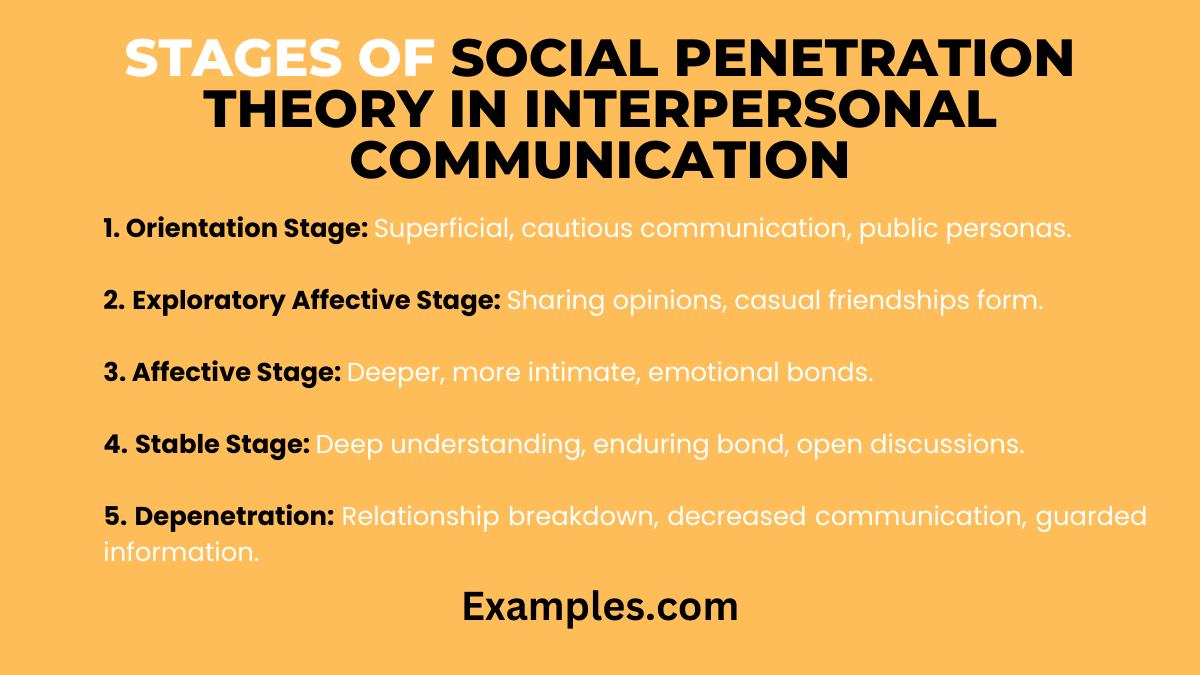
- Orientation Stage: This initial phase is marked by superficial communication and small talk. Conversations are generally cautious, and individuals are not yet comfortable sharing personal information. This stage is often characterized by public personas rather than private selves.
- Exploratory Affective Stage: Here, individuals begin to reveal more about themselves, engaging in more personal, yet still cautious, exchanges. Topics might include personal opinions or general beliefs. This is the stage where casual friendships often form.
- Affective Stage: Communication becomes more spontaneous and intimate in this stage. Individuals start sharing deeper aspects of their personality and begin to display their true selves. Emotional bonds, deeper trust, and personal disclosures are more evident.
- Stable Stage: At this point, individuals have a deep understanding of each other’s personalities and communication patterns. They can predict each other’s reactions and understand underlying reasons for behavior. This stage represents a strong, enduring bond where personal and private matters are openly discussed.
- Depenetration (Optional): This stage occurs if the relationship starts to break down. It’s characterized by decreased quality and quantity of communication. Personal information once shared may become guarded again, signifying a regression or end of the relationship.
Understanding these stages in the context of Interpersonal Communication is crucial for both personal and professional growth. Recognizing which stage a relationship is in can guide appropriate communication strategies. For instance, in a professional setting, understanding these stages can enhance team collaboration and conflict resolution.
Incorporating principles of Social Penetration Theory into various types of interpersonal communication, such as Verbal Communication in Interpersonal Communication or Non-Verbal Communication in Interpersonal Communication, can greatly enhance the depth and effectiveness of interactions. Whether in developing deeper personal relationships or fostering effective team dynamics in a workplace, recognizing and applying these stages can lead to more meaningful and productive connections.



